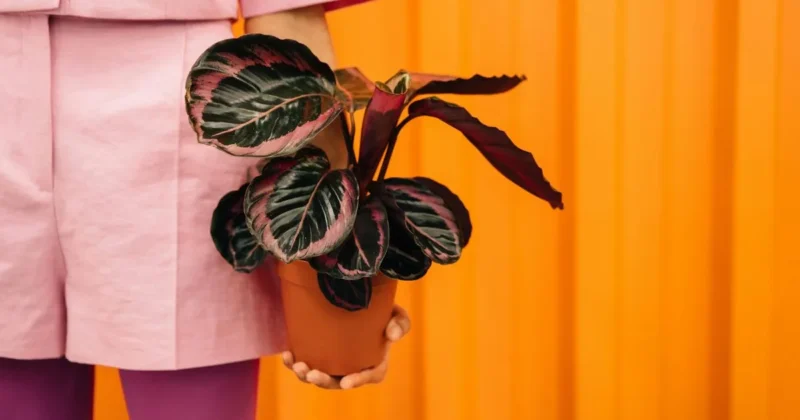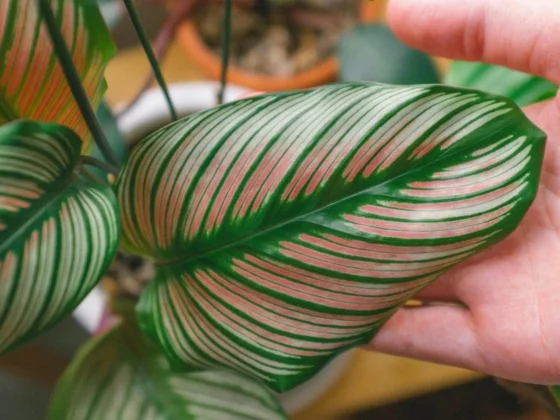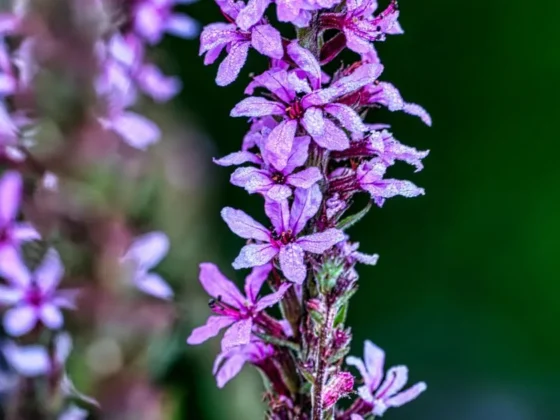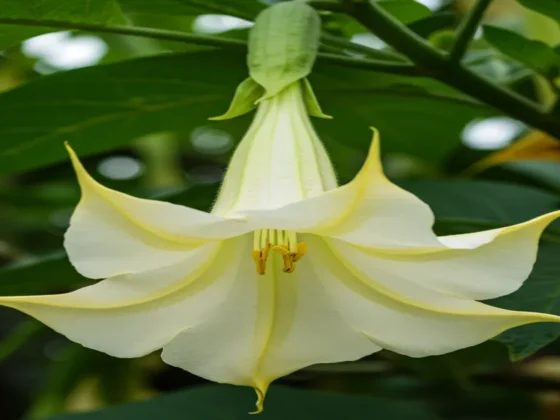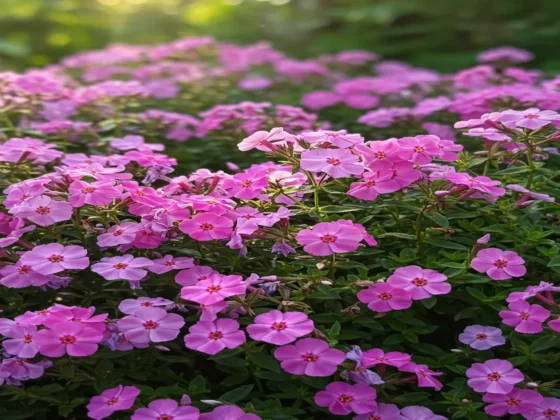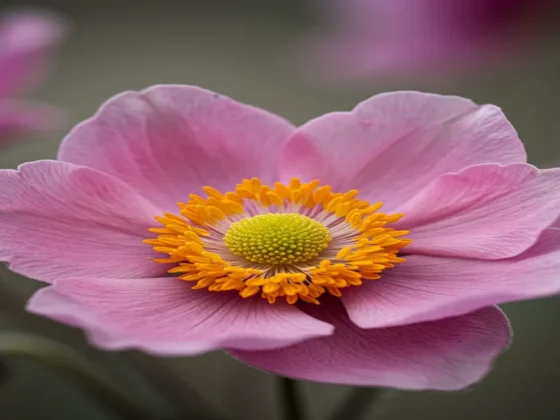Explore the magical world of the Calathea Couture Purple. This houseplant brings vibrant purple leaves into your home. Our guide will show you how to care for your Calathea, keeping it healthy and stunning.
The Calathea Couture Purple is a standout in any plant collection. Its detailed leaves and deep colors need special care. Knowing how to care for it will make your plant thrive.
What Is Calathea Couture Purple ?
Explore the magical world of the calathea couture purple. It’s a stunning plant that has won the hearts of many indoor plant lovers. Its vibrant purple leaves and unique traits add exotic beauty to your home.
Origin and Natural Habitat
The calathea couture purple comes from South America’s lush tropical areas. It loves warm, humid places. This helps us understand how to care for it.
These plants live on rainforest floors. They get filtered light and stay moist.
- Tropical rainforest regions of Brazil
- Understory plant with low light adaptation
- Naturally grows in humid, protected environments
Distinctive Features and Characteristics
The calathea couture purple stands out with its stunning leaves. The leaves have deep purple undersides and detailed patterns, like they were painted by nature.
Its key features are:
- Vibrant purple leaf undersides
- Intricate leaf patterns
- Leaf movement that follows light conditions
Benefits as a Houseplant
Having a calathea couture purple at home is more than just pretty. It’s a natural air purifier, making your indoor space healthier. It brings tropical elegance and improves air quality, reducing stress.
Whether you’re new to plants or have experience, the calathea couture purple will enchant you. It’s a great choice for your indoor garden.
Why Do Prayer Plants Move ?
Calathea plants, like the Couture Purple, have a cool trick called nyctinasty. This makes them fold their leaves like hands in prayer at night. It’s a pretty sight.
The leaves of these plants move in a special way. They spread out during the day to catch sunlight. Then, as night falls, they fold up, looking like they’re praying.
Key Characteristics of Nyctinasty
- Leaves fold upright during nighttime
- Responds to light and darkness cycles
- Demonstrates plant’s biological rhythm
- Helps regulate internal plant metabolism
This nightly move is important for the plant. It keeps the plant warm and saves water. It also helps the plant’s internal workings.
| Time of Day | Leaf Position | Biological Purpose |
|---|---|---|
| Daytime | Flat and Expanded | Photosynthesis Maximization |
| Nighttime | Folded Upright | Temperature & Moisture Protection |
Knowing about this movement helps you care for your calathea plant better. By matching the plant’s natural light cycle and keeping the right humidity, you support its nightly dance.
Optimal Growing Conditions
To grow your Calathea Couture Purple well, you need to know what it likes. This houseplant is delicate and needs the right conditions to thrive.
Temperature Requirements
Your Calathea Couture Purple likes a steady temperature between 65-80°F (18-27°C). Avoid sudden changes in temperature. Keep it away from cold drafts and air conditioning vents.
- Ideal daytime temperature: 70-75°F
- Minimum nighttime temperature: 60°F
- Avoid temperatures below 55°F
Humidity Levels
Humidity is key for your Calathea plant. These tropical plants need high moisture to keep their purple leaves bright.
| Humidity Level | Plant Response |
|---|---|
| 50-60% | Adequate |
| 60-70% | Optimal |
| Below 50% | Potential Stress |
To boost humidity, try a pebble tray, group plants, or get a small humidifier.
Light Exposure Needs
The Calathea Couture Purple needs bright, indirect light. Direct sunlight can burn its leaves. Too little light will dull its color.
- Best location: Bright, indirect light
- Avoid direct afternoon sun
- Rotate plant periodically for even growth
Soil and Potting Requirements
Choosing the right soil and pot is key for your Calathea Couture Purple to thrive. It needs soil that’s like its natural home in the tropics. The soil should drain well but also hold moisture.
Your calathea needs a special soil mix for the best growth. Here’s what it should have:
- 2 parts peat moss
- 1 part perlite
- 1 part orchid bark
- Small amount of activated charcoal
Choosing the right pot is also important. Look for pots with lots of drainage holes to avoid waterlogged soil. Ceramic or terracotta pots are best. They let moisture evaporate and keep the roots cool.
When it’s time to repot, pick a pot that’s 1-2 inches bigger than the old one. This helps your plant adjust and grow its roots. Repot every 12-18 months or when the roots start to crowd the pot.
| Pot Material | Drainage | Moisture Retention |
|---|---|---|
| Ceramic | Good | Moderate |
| Terracotta | Excellent | Low |
| Plastic | Moderate | High |
Pro tip: Always ensure your potting mix is fresh and free from old, compacted soil to prevent potential root diseases.
Watering Schedule and Techniques
Learning how to water your Calathea Couture Purple is key. These plants need the right amount of moisture to stay healthy. They love their vibrant purple leaves to stay bright and strong.
Water Quality Considerations
Water quality is very important for your Calathea Couture Purple. Tap water can be too harsh because of chemicals like chlorine and fluoride. Here are some better options:
- Filtered water
- Rainwater collection
- Distilled water
- Let tap water sit for 24 hours before use
Signs of Under and Overwatering
It’s important to know when your plant needs more or less water. Look out for these signs:
Underwatering Symptoms:
- Crispy leaf edges
- Drooping leaves
- Dry soil surface
Overwatering Symptoms:
- Yellowing leaves
- Soft, mushy stems
- Standing water in pot
Seasonal Watering Adjustments
Watering needs change with the seasons. In spring and summer, water more often. In fall and winter, water less to avoid root rot.
Keep the soil moist but not too wet. Check the soil with your finger. Water when the top inch feels dry. This way, your plant gets the right amount of water without getting too much.
Feeding and Fertilization Guide
Proper nutrition is key for a healthy calathea plant. Your Calathea Couture Purple needs balanced feeding to stay vibrant. This ensures its purple leaves shine.
Understanding your calathea’s nutritional needs is crucial. The right fertilization can greatly improve your plant’s health and look.
- Use a balanced, water-soluble fertilizer with equal NPK ratios
- Dilute fertilizer to half-strength to prevent root burn
- Apply fertilizer during active growing seasons (spring and summer)
Feed your Calathea Couture Purple every 4-6 weeks when it’s growing. Avoid fertilizing during winter months when the plant enters dormancy.
Look out for signs of nutrient deficiencies. These include:
- Yellowing leaves
- Stunted growth
- Pale or faded leaf color
Organic options like diluted fish emulsion or compost tea are good. They offer natural nutrition. Always check how your plant reacts and adjust your fertilization plan.
Common Pests and Disease Management
Keeping your calathea plant healthy means watching out for pests and diseases. The calathea couture purple is especially delicate. It can easily get sick from its environment, harming its beautiful leaves and health.
Identifying Common Issues
It’s important to catch problems early to keep your calathea couture purple thriving. Look out for these signs of pests:
- Tiny web-like structures indicating spider mite presence
- White cottony masses signaling mealybug infections
- Yellow or brown spots suggesting fungal diseases
- Leaf discoloration or unusual texture changes
Natural Treatment Methods
For your calathea plant care, use safe treatments:
- Neem oil for natural pest control
- Gentle soap solution for washing away soft-bodied insects
- Pruning infected areas to prevent spread
- Introducing beneficial predatory insects
Prevention Strategies
It’s better to prevent pests and diseases than to treat them. Here are some ways to keep your plant safe:
- Maintain consistent humidity levels
- Ensure proper air circulation
- Regularly inspect plant leaves
- Keep plants clean and dust-free
- Quarantine new plants before introducing them to your collection
Knowing the risks and using the right care can keep your calathea couture purple looking great. It will stay vibrant and stunning.
Pruning and Maintenance Tips
Keeping your Calathea Couture Purple in top shape needs careful attention. It’s all about the right pruning and upkeep to keep it looking great. This beautiful plant needs a soft touch and specific care.
Here’s what to do when pruning your Calathea Couture Purple:
- Use clean, sharp pruning shears to prevent damage
- Remove yellow, brown, or dead leaves at the base
- Cut close to the main stem without damaging healthy tissue
- Prune during the active growing season (spring and summer)
Cleaning is key for Calathea types to keep their leaves looking good. Dust can block the plant’s ability to photosynthesize effectively. Use a soft, damp cloth to gently wipe leaves and keep them shiny.
Here are some important maintenance steps:
| Maintenance Task | Frequency | Purpose |
|---|---|---|
| Leaf Cleaning | Bi-weekly | Remove dust, maintain photosynthesis |
| Pruning | As needed | Remove damaged leaves, promote growth |
| Misting | 2-3 times weekly | Increase humidity, prevent leaf crisp |
Misting helps mimic the tropical home these plants prefer. Use water at room temperature and spray lightly to avoid wetting the leaves too much. Regular care will keep your Calathea Couture Purple a beautiful part of your indoor plants.
Propagation Methods and Techniques
To grow more Calathea Couture Purple plants, you need to know the best ways to do it. This method lets you make new plants from an old one. It’s a great way to increase your collection.
Propagating plants is a careful task. It needs patience and attention to detail. For Calathea Couture Purple, the best way is to divide the plant. This way, you can make new plants from a healthy parent plant.
Division Process Step-by-Step
- Select a mature, healthy Calathea Couture Purple plant
- Prepare clean, sharp gardening tools
- Remove the plant carefully from its current pot
- Gently separate root clusters with minimal damage
- Ensure each division has healthy roots and leaves
Optimal Propagation Timing
The best time to propagate your Calathea plant is in the spring or early summer. These seasons are perfect because the plant is growing well.
| Propagation Season | Success Rate | Plant Condition |
|---|---|---|
| Spring | High (90%) | Active growth |
| Early Summer | High (85%) | Strong root development |
| Late Fall/Winter | Low (30%) | Dormant growth |
After dividing, put the new plants in a warm, humid spot with indirect light. Keep the soil moist but don’t let it get too wet. This helps them grow well.
Watch your new plants closely for the first few weeks. This ensures they grow strong and healthy.
Troubleshooting Common Problems
Keeping your prayer plant healthy at night needs careful watching and quick action. Calathea Couture Purple faces many challenges that can harm its look and health.
Leaf problems are common in calathea care. Look out for these important signs:
- Leaf Curling: Shows environmental stress
- Brown Leaf Edges: Means moisture or humidity issues
- Color Fading: Shows not enough light
- Less Prayer Movement at Night: May mean health problems
Knowing the causes helps you fix problems fast.
| Problem | Potential Cause | Solution |
|---|---|---|
| Leaf Browning | Low Humidity | Increase humidity with pebble tray or humidifier |
| Reduced Night Movement | Insufficient Water | Maintain consistent soil moisture |
| Color Loss | Direct Sunlight | Move to indirect light location |
Pro Tip: Regular checks stop most Calathea health issues. Inspect your plant weekly for early signs.
Your Calathea Couture Purple does well with careful, quick care. Knowing these common problems helps keep your prayer plant healthy and stunning.
Conclusion
Caring for a Calathea Couture Purple needs dedication and knowledge. This beautiful plant adds vibrant purple leaves and detailed patterns to any room. By following the care tips in this guide, you can grow a stunning Calathea.
Learning about the Calathea Couture Purple is worth it. It not only looks amazing but also purifies the air. Paying attention to humidity and leaf movement is crucial. With the right care, it will become a stunning centerpiece in your home or office.
Every plant is different, and your Calathea will adjust to your care. Being patient and watching it closely is important. With this guide, you can create the perfect home for your Calathea and enjoy its beauty.
Start your plant care journey and let your Calathea Couture Purple show off your skills. Your hard work will pay off with a healthy, captivating plant that will inspire you every day.
FAQ
What makes the Calathea Couture Purple unique among houseplants ?
The Calathea Couture Purple is special because of its beautiful purple leaves. It also has a cool prayer plant movement. Leaves fold up at night and open in the day. This makes it a standout in any room, adding beauty and wonder.
How much humidity does a Calathea Couture Purple require ?
These plants love high humidity, best between 50-60%. You can boost humidity with a humidifier or a pebble tray. Grouping plants together also helps create a humid microclimate.
What type of light is best for my Calathea Couture Purple ?
It needs bright, indirect light. Stay away from direct sunlight to prevent leaf damage. A north or east window is perfect, offering gentle morning light.
How often should I water my Calathea Couture Purple ?
Water when the top inch of soil is dry, about every 7-10 days. Use room temperature, filtered water. Keep the soil moist but not too wet.
Why are the leaves of my Calathea Couture Purple turning brown ?
Brown leaves can mean low humidity, hard water, or uneven watering. Use filtered water and keep humidity high. Water regularly and trim brown leaves to prevent more damage.
Can I propagate my Calathea Couture Purple ?
Yes, you can divide it in spring or early summer. Separate the roots carefully, making sure each part has leaves and roots. Repot in well-draining soil and keep it in good conditions.
What temperature range is ideal for this plant ?
It prefers 65-80°F (18-27°C). Avoid cold drafts and sudden temperature changes. Keep it away from air conditioning vents and cold windows in winter.
How do I prevent pest infestations on my Calathea Couture Purple ?
Keep your plant clean and well-ventilated. Regularly check for pests. If you find any, treat with neem oil or insecticidal soap and isolate the plant.
How often should I fertilize my Calathea Couture Purple ?
Fertilize monthly in spring and summer with a balanced fertilizer. Dilute it to half strength. Don’t fertilize in fall and winter when the plant grows slower. Too much fertilizer can harm the roots.
Why is my Calathea Couture Purple not showing its prayer plant movement ?
It might be stressed from wrong light, humidity, or temperature. Make sure it gets consistent indirect light, high humidity, and stable temperatures. Healthy plants will show this cool movement naturally.


